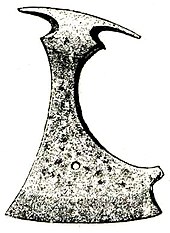Bearded axe
The hook or "beard", i.e. the lower portion of the axe bit extending the cutting edge below the width of the butt, provides a wide cutting surface while keeping the overall mass of the axe low.
The "beard" of the axe would also have been useful in battle, for example to pull a weapon or shield out of a defender's grasp.
Through Scandinavian mercenaries fighting in the Varangian Guard, the design entered the Byzantine Empire.
After the Ottoman conquest of Constantinople, the Sultan's guard adopted axes of similar design to underline their continuity with the Byzantine Empire.
Through Ottoman influence, these axes would spread to Poland and Hungary, where they would become known as "Czekan."


